Keshi Yena is a traditional dish born in the Caribbean islands of Curaçao and Aruba. It is a large portion of cheese hollowed out and stuffed with spiced meat and vegetables. It is served either steamed or baked, and is a popular dish to enjoy while visiting the Aruba islands.
In this recipe, we are going to enjoy it baked, and we’ll be making it vegetarian, served with a side of sliced baguette. If you would like to add meat to it, it’s pretty simple, add ground chicken or beef and cook through before the vegetables, and follow the rest of the recipe as-is.
In this wild world of ours, sometimes the best history lessons are seen – and tasted – right in front of us.
Certainly that’s the case with keshi yena and Curaçao. Even in the smallest of these simple, inauspiciously prepared stuffed cheese casseroles, you’ll find a wealth of historical influences, both from the outside and within the island.
That it tastes so great is, you could say, an added bonus.
Keshi Yena, The Slave Trade and Curaçao’s Melting Pot
Much of the developmental trajectory that Curacao has experienced is not unlike what we’ve seen before in Caribbean islands like Haiti, Jamaica or Belize. The general gist is that a local population is supplanted by an outside European colonial force, which in turn leads to major shifts in both the cultural and political norms on the island.
A key difference here, though, is that the leading influence didn’t come from the Spanish or the Portuguese, rather it came from the Dutch. And while this might not seem like much in the greater colonialist scheme of things, it’s this difference that has led to a special uniqueness in much of the local Curaçaoan way.

Curaçao’s Dutch Colonialism
Like elsewhere in the Caribbean, Curaçao was originally inhabited by the Arawaks, an Amerindian tribe stemming from the northern regions of South America. Its proximity to the mainlands that make up modern-day Venezuela made it some of the first Caribbean islands to be settled by indigenous peoples.
Similarly to other Caribbean islands, Curaçao too was initially explored and settled by one of the premier colonial powers in the region: Spain. The Spanish, led by explorer Alonso de Odeja in 1499, inaugurated the island’s European presences and used it as a midway trading port between the empire’s territories in Hispaniola and South America. However, the Spanish were generally unimpressed with the island and its lack of natural resources, and so Curaçao would remain a relative geopolitical afterthought for the next 140 years.
The Spanish – and even the Portuguese – nevertheless left their indelible mark on the island. Both Spanish and Portuguese constructs play a role in the local language papiamentu, and a prevailing theory suggests that the island’s name stems from the Portuguese term ilha da curaçao, or “island of healing,” as sickly sailors on the island would miraculously recover from terrible bouts of scurvy thanks to the local climate and improved intake of Vitamin C.
It was under the Dutch, though, that the island really grew into a regional economic power. To this point, the Dutch themselves had just gained independence from the Spaniards following the Eighty Years’ War, which kicked off a period of economic and cultural prosperity referred to as the Dutch Golden Age. Already a fairly enterprising and business-savvy population, the Dutch were now able to explore and colonize in their own right, and Curaçao became an early prize of theirs.
Whereas the Spaniards disregarded Curaçao as a worthless colony with no valuable natural resources, the Dutch viewed things a little differently and, you could say, more optimistically. By 1634, the Dutch-operated West India Company gained control of the island away from the Spanish – who didn’t put up much of a defense at all – and began work on a new capital Willemstad.
You May Also Like
If you love this casserole, you might want to check out our other recipes on other popular casseroles such as a potato root vegetables casserole from Pom Surinam, or the meatloaf casserole from South Africa (bobotie)
The Slave Trade and Economic Prosperity
For much of Curacao’s early history as a Dutch colony, the local economy revolved around one thing: the slave trade. To meet the increasing demand of plantation laborers, the Dutch West India Company built an operation of kidnapping thousands of West Africans and bringing them to the New World. Because of its fortuitous location right in between the South American and Caribbean colonies, Willemstad served as the first point of entry into the region for the incoming trade routes before dispersing the slaves to other lands around the region.
For the remainder of the 17th century and the early parts of the 18th, Curaçao developed into the most lucrative and profitable slave trade market in the entire New World, a growth that did not go at all unnoticed. Merchants, traders, sailors and laborers alike would make Willemstad their first destination point into the New World, some of whom would use it as a springboard to find their next contract or employment opportunity.
In addition to serving as a midway point for moving slave labor, Curaçao developed other industries in which it too needed some of the labor supply. Especially as areas like the local salt industry began to prosper, slavery also became a part of local Curacaoan life until its abolition in the 19th century.
This is the crucial period in the island’s history that we first see the concept for the keshi yena recipe created.
The (Quite Literal) Melting Pot
It should be no secret that the Dutch, no matter where they are in the world, love their cheese.
In particular, the Dutch plantation masters loved the cheeses like Edam and Gouda made back in the homeland, so much so that big wax-covered wheels of the cheese would be shipped and imported into the island.
For the wealthy, the de facto way of enjoying their cheese would be to core out the sweeter, creamier pieces of cheese from the center. As the cheese wheel would get eaten and its cheesy supply depleted, the Dutch owners wouldn’t even bother with the harder, almost waxy rinds on the outside of the wheel. Instead, they would offer these glorified table scraps to their slaves to eat.
The creation of keshi yena from here is nothing short of genius. The kitchen workers would peel off the wax, soak the hardened rinds in water to soften, create a filling made from other leftover table scraps – chicken, vegetables, etc – and then steam everything together in a bain-marie to create an entirely new re-invented, casserole style dish.
Once made, the original keshi yena covered almost all the basic nutrient needs and was calorically rich enough to keep the slave communities reasonably fed, although what’s made the recipe last is its contrasting flavor profiles.

About the Recipe
To understand what keshi yena is really all about, you need to look no further than its Papiamentu-to-English translation: stuffed cheese.
Nowadays, you can use all parts of the cheese and not just the harder outer rinds, but the principles behind keshi yena are the same as they were upon its original genesis.
To start, you’ll want to take some cheese, preferably Gouda or Edam in honor of the traditional recipe. It’s not as common anymore to hollow out an existing wheel, but instead you’ll recreate a cheese casing with the help of thinly cut easily pliable slices of cheese.
Where keshi yena gets much of its taste from is in the Caribbean-inspired spiced filling. Normally, you might have a filling that features some meats or shredded chicken (though in ours, you’ll see we went vegetarian), but really anything you have in the kitchen can work. That type of all-encompassing versatility is one of the real positives of this cheese casserole dish.
You start preparing the filling by sautéing your meats and vegetables together as the vegetables slightly soften. From there, you might add ingredients that lend strong flavorings like capers (for salty), raisins (for sweet) or Scotch bonnet peppers (for hot). Add in dashes of soy sauce and/or ketchup, and then take your filling off to let it cool. Fold in some beaten eggs into the cooled filling mixture, and you’re ready to put it all together.
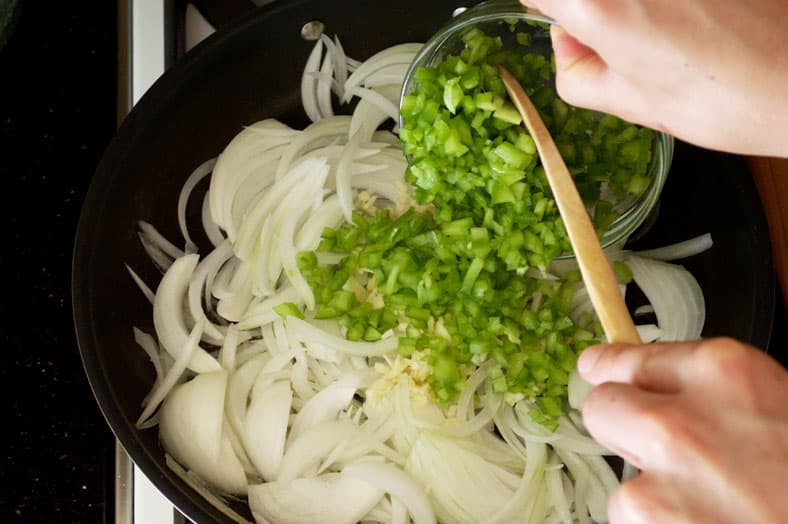

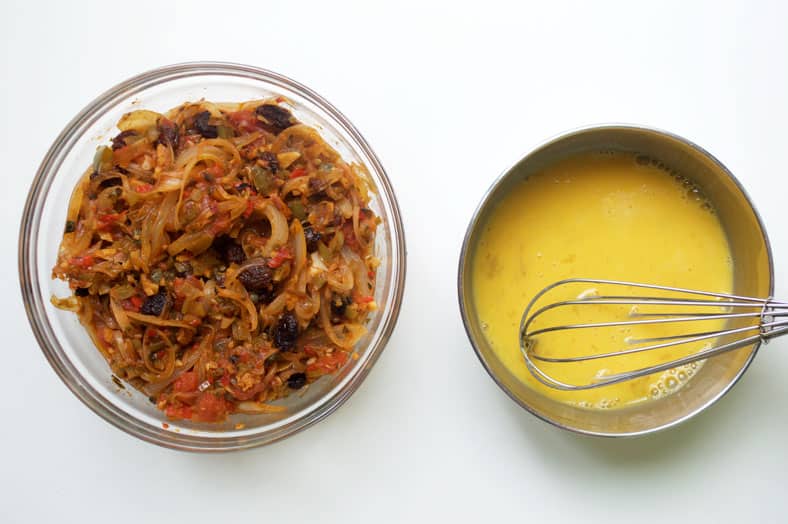

While the traditional keshi yena involved steaming and a bain-marie, it’s less common nowadays to prepare it in this way, although some recipes will still suggest it. More easily, however, is to take an oven-safe bowl and to line it with your cheese slices to put together well-covered cheesy cavity.

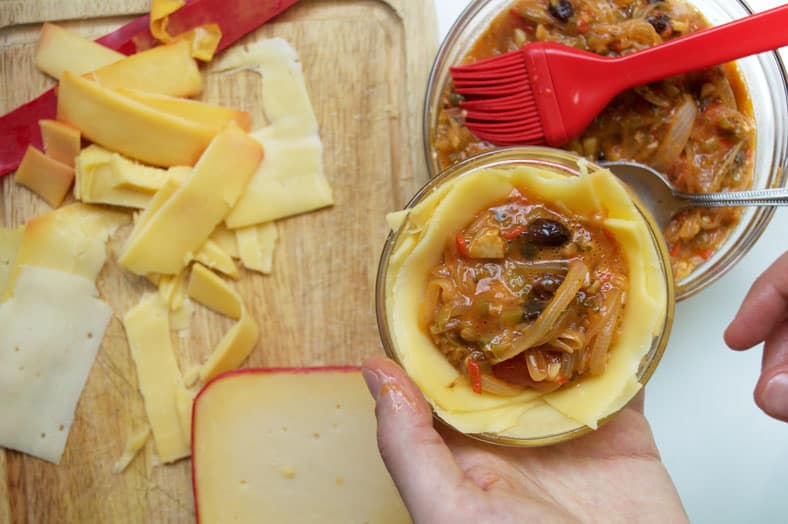
Next will come some of your filling, which you’ll pile in and add on as much as you can. You will want to keep in mind that, because of the beaten egg mixed, the filling will expand slightly in the oven, but really the more filling you can fit the better. Finish by sealing your keshi yena off with some more slices of cheese at the top to create an enclosure, then pop it in the oven and let it bake until golden brown.
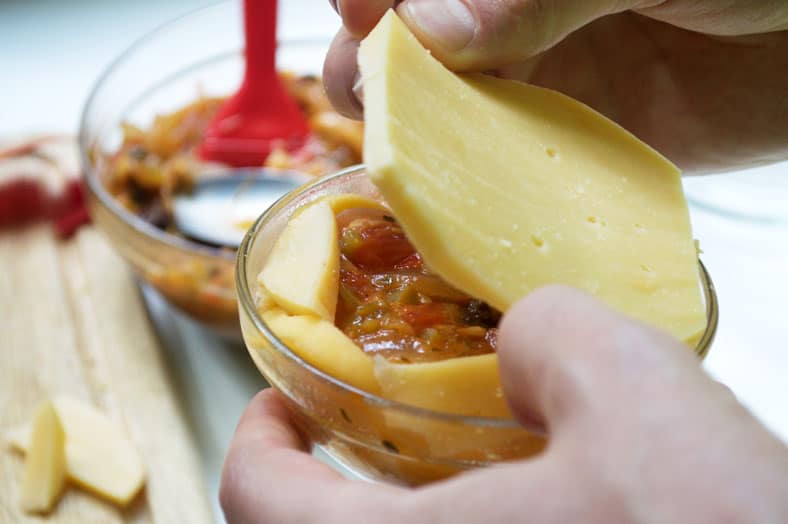
When it’s done baking, the cheese will have melted and sealed all the filling in and ideally have developed a nice golden crust around the top and sides as well. To serve, simply pop it out either of the wax or your baking dish, and enjoy with some slices of fresh baguette!
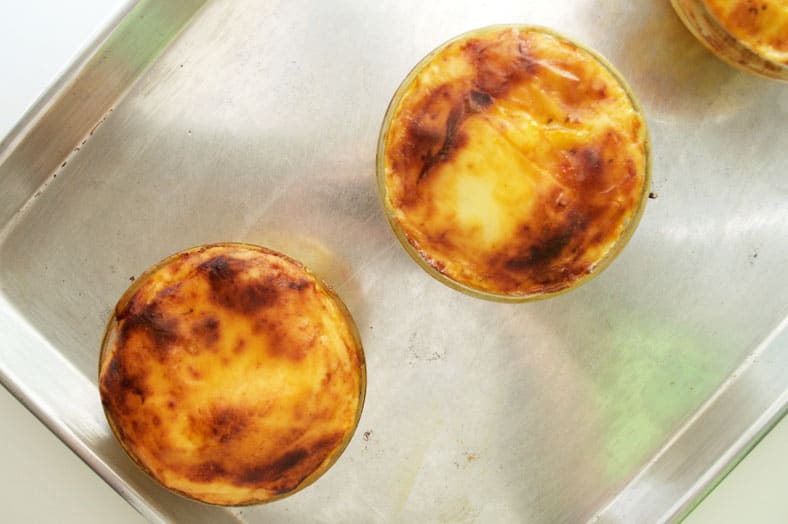
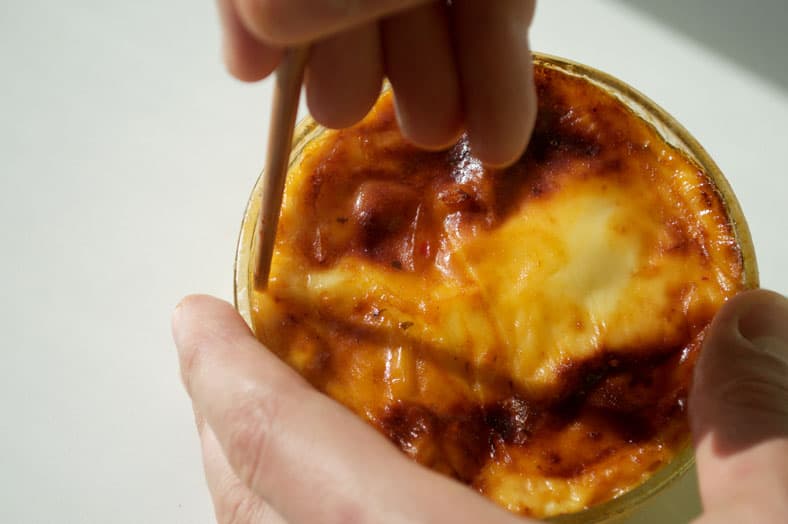
Our Take on the Recipe
We came across a lot of fun recipes for keshi yena during our research process, and while there were a lot of fun ones to choose from, we ended up choosing two in particular to serve as our original reference recipe sources. In the end, we just liked their overall approach and presentation to the dish as a whole.
Still, we did make some tweaks and changes per usual. For starters, we swapped out any calls for vegetable oil and instead used healthier oils like coconut and olive for our cooking. We also changed up various ingredients like tomato paste instead of ketchup and fresh chili peppers instead of hot sauce. We did, however, stay away from the habanero this time around.
More as a personal challenge than anything else, we wanted to see if we could make a really delicious vegetarian-friendly filling for our keshi yena. We think we pulled it off with the help of ingredients like capers, olives and increased amounts of bell peppers and onions, but that’s completely subject to our own taste preferences and slightly biased opinions.
Either way, keshi yena is a really wonderful recipe that highlights the pleasures of what a simple, well-rounded meal can look like. That it involves a whole lot of melted cheese is, well, just that much more fun too.
Enjoy!
What would you put as filling in your keshi yena? Comment below!

Food styled by: Phil Roepers

